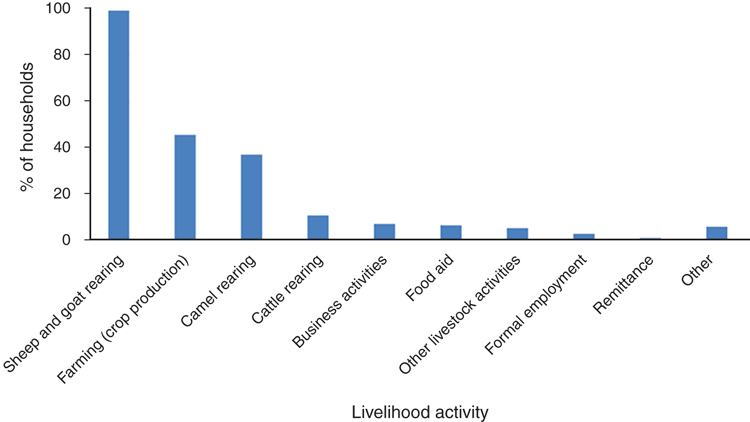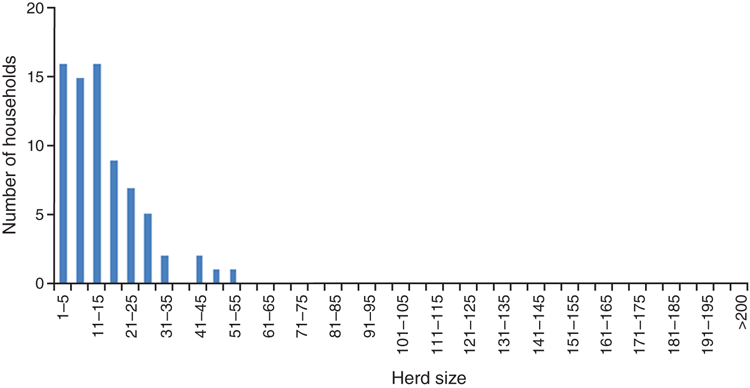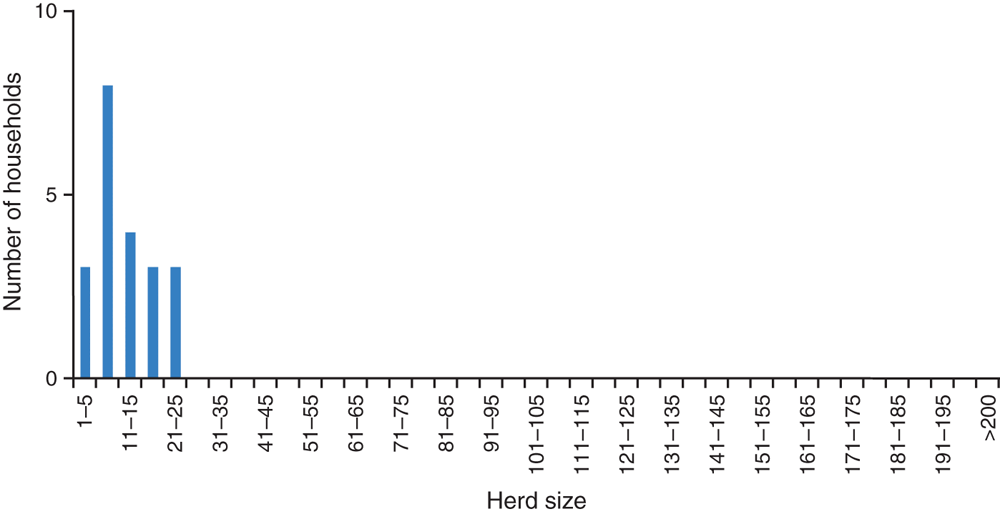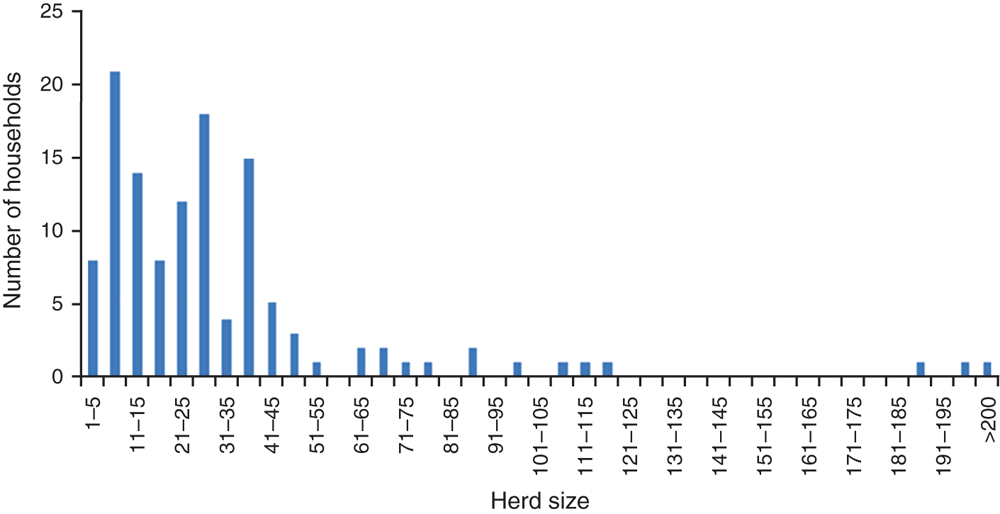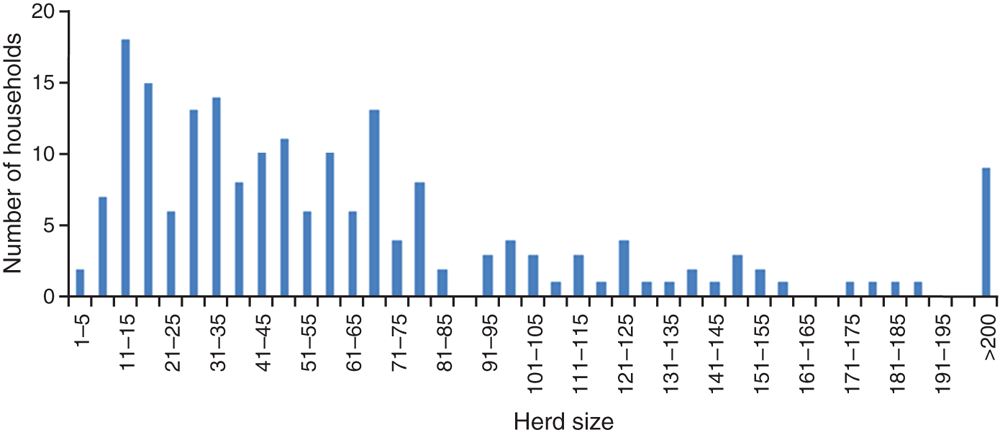The traditional livestock breeding practices of women and men Somali pastoralists: breeding management and beliefs on breeding issues
Karen Marshall A D , Nadhem Mtimet A , Francis Wanyoike A , Nicholas Ndiwa A , Haileselassie Ghebremariam B , Lawrence Mugunieri C and Riccardo Costagli CA International Livestock Research Institute, PO Box 30709, Nairobi, 00100, Kenya.
B IGAD Sheikh Technical Veterinary School, Sheikh, Somaliland.
C Terra Nuova, PO Box 74916, Nairobi, 00200, Kenya.
D Corresponding author. Email: kmarshall@cgiar.org
Animal Production Science 59(8) 1568-1583 https://doi.org/10.1071/AN17481
Submitted: 18 July 2017 Accepted: 25 September 2018 Published: 27 November 2018
Journal Compilation © CSIRO 2019 Open Access CC BY-NC-ND
Abstract
In Somalia, located in the horn of Africa and one of the world’s poorest countries, livestock are the mainstay of the economy. While strengthening the livestock sector is considered key to reduced poverty and increased food security, few studies have reported the livestock management practices of Somali pastoralists, including on breeding issues. Here, we present the final of a series of papers documenting the breeding practices of women and men Somali pastoralists for goat, sheep, camel and cattle. Data for the study were obtained by surveying 200 livestock-keeping households located within the Tog-Dheer region of Somaliland. The most important livestock species kept, in terms of contribution to household livelihood, were goats and sheep, followed by camel, then cattle. Migration with livestock was practiced by two-thirds of the households for some or all of the year, whereas other households were settled with their livestock. On breeding practices, the main means of acquiring breeding animals was by the animal being born into the herd, and varied means were used to control mating, including castration, culling, separation of male and female animals, purposeful mating of best males to best females, and controlling the size of mating groups. On beliefs on breeding issues, the pastoralists had a varied understanding of whether specific livestock traits were influenced by genetics, environment, or a combination of both, and most could not articulate the basis of inheritance. Knowledge of inbreeding was poor, with almost all respondents indicating they did not consider the mating of related animals to be problematic. Additionally, some pastoralists tried to influence the sex of the livestock progeny born through various practices. Overall, the finding presented here and in the companion studies (Marshall et al. 2014, 2016) indicated that the women and men Somali pastoralists generally employ sound breeding practices, although there is room for capacity building such as on inbreeding.
Additional keywords: camel, cattle, goat, sheep, Somaliland.
Introduction
In Somalia, a country located in the horn of Africa and one of the world’s poorest countries, livestock are the mainstay of the economy. The livestock sector engages ~65% of the population, and contributes ~40% of the national GDP, with millions of animals, particularly goats and sheep, being exported to the Middle East annually (SCCIA 2014).
Livestock are kept by pastoralists and agro-pastoralists, and are typically their primary livelihood activity. The environment where the livestock are raised is often harsh, with high temperatures and limited feed and water, and droughts are frequent (Somalia NAPA 2013; OCHA 2016). The most numerous livestock species are goats and sheep, followed by cattle and camel (SCCIA 2014). Mixed-species herds are often kept. Traditionally, the herding of goats and sheep (as well as the home milking herd of camel and cattle) is performed by women, children and the elderly, and the herding of camel and cattle is performed by men (National Livestock Policy Republic of Somaliland 2006; FSNAU-Somalia 2012). Livestock keepers may be nomadic, i.e. migrating with their livestock in search of pasture and water, for some or all of the year.
Although strengthening the livestock sector is considered to be the key to poverty reduction and increased food security in Somalia (FAO 2010), few studies have reported the livestock management practices of Somali livestock keepers, including on breeding issues. So as to help address this knowledge gap, we have recently documented the livestock-keeping objectives, trait preferences of, and selection criteria used by, women and men pastoralists in Somaliland (located in north-western Somalia), for goats, sheep, cattle and camel (Marshall et al. 2014, 2016). The livestock-keeping objectives varied by gender of the pastoralist as well as livestock species; however, all species were kept for multiple objectives. The most important of these included domestic milk consumption, income from the sale of milk, slaughter animals and breeding animals, savings and insurance, domestic meat consumption, transport and load carrying, drawing water from wells, ceremony and dowry and hide use (Marshall et al. 2014). The livestock trait preferences of, and selection criteria used by, the pastoralists also varied by pastoralist gender and livestock species, but aligned well with the harsh environment under which the animals perform, the pastoral livestock-keeping objectives and the market requirements (Marshall et al. 2016).
The work presented here forms a companion paper to the above-mentioned papers, and concludes our documentation of breeding practices of Somali women and men pastoralists. It focuses on additional issues, including the importance of livestock to household livelihoods and livestock risk-reduction practices, herd structure and species mix, herding arrangements and migration patterns, breeding practices, including sources of breeding animals, beliefs on breeding issues and constraints to livestock production and breeding, among others.
Materials and methods
Data-collection overview
Data presented in the present report were obtained from a household questionnaire survey with female and male pastoral livestock keepers conducted in the Tog-Dheer region of Somaliland (north-western Somalia), between November 2013 and February 2014. The household surveys were conducted on 200 households in this region, being representative of two livelihood zones (FSNAU-Somalia 2014), namely, the West Golis livelihood zone (100 households from 10 settlements) and the Tog-Dheer livelihood zone (100 households from 10 settlements). Maps of the study site are given in Fig. 1.
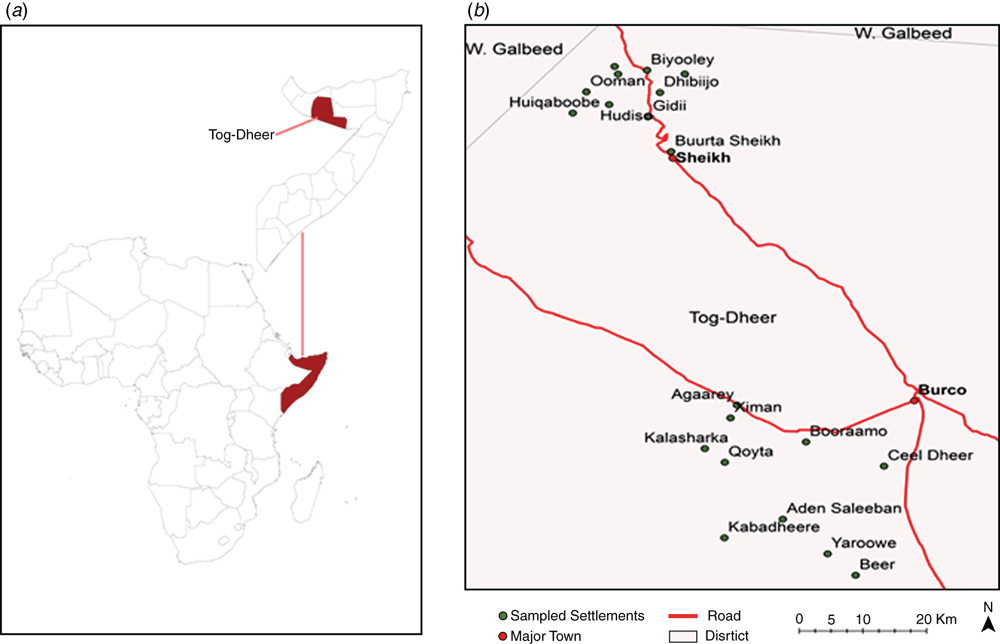
|
Selection of study sites, settlements and households
Somaliland comprises five regions; the central Tog-Dheer region was selected as the study site on the basis of it housing the IGAD Sheikh Technical Veterinary School and Reference Centre who participated in implementing the study. Somaliland has further been mapped into 19 livelihood zones (FSNAU-Somalia 2014), with four livelihood zones (Tog-Dheer, West Golis, Nugal Valley and Hawd) represented in the Tog-Dheer region. Of these four, the Tog-Dheer and West Golis livelihood zones were selected as the focus of the study due to the importance of livestock keeping (particularly goat and sheep) within these zones and accessibility to field staff (significant areas of the other livelihoods zones were not accessible due to security concerns).
The number of settlements within the Tog-Dheer region and selected livelihood zones was 95 for the Tog-Dheer livelihood zone and 251 for the West Golis livelihood zone. These settlements were classified as being either less than or more than 10 km from a livestock market. For each combination of livelihood zone and market distance, five settlements were randomly selected to participate in the survey. Note that the stratification on distance to market was to accommodate the needs of a simultaneous market study (as reported in Wanyoike et al. 2015).
Within each settlement, 10 households were interviewed, after randomly selecting them from a list of livestock-keeping households in the settlement that was provided by the settlement leaders. A household was defined as all people living together, who eat together, and/or have a common revenue-generating activity together, who recognise the authority of a man or a woman (or men or women) who is (are) the head(s) of the household.
Site description
The Tog-Dheer region of Somaliland has a human population of ~400 000 people, of which the majority are nomadic pastoralists (65%), while others are living in urban areas (30%) or agro-pastoralists (5%; FSNAU-Somalia 2011).
The West Golis and Tog-Dheer livelihood zones are classified as pastoral and agro-pastoral respectively (FSNAU-Somalia 2005; FSNAU-Somalia 2011, 2014a). The main species of livestock kept in both livelihood zones are goat, sheep, camel and cattle. In the Tog-Dheer livelihood zone, the main crop types include sorghum, maize, cowpea, water melon and vegetable. There are two dry and two wet seasons annually, with the dry seasons between January and March, and July and September, and the wet seasons between April and June and October and December. The West Golis livelihood zones have more reliable water sources than does the Tog-Dheer livelihood zone, due to being more mountainous and, thus, having a higher mountain runoff. The estimated rural human population of the West Golis livelihood zone within the Tog-Dheer region is 23 689, and that for the Tog-Dheer livelihood zone within the Tog-Dheer region is 19 864 (FSNAU-Somalia 2014b). Assuming an average household size of 6.6 (results from the present study), this equates to 3589 and 3010 households respectively, for West Golis and Tog-Dheer livelihood zones within the Tog-Dheer region.
Household survey
The household survey collected data on several issues, including the following: household demographics, livelihood activities and type of livestock production system(s) practiced; herd size and composition; animal ownership and entrustment to others; herding arrangements and related labour; migration patterns and constraints to migration; breeding practices; beliefs on breeding issues; and practices to reduce risks to livelihoods from livestock losses. Information on marketing practices was also collected, and documented in Wanyoike et al. (2015). The survey questions were mostly closed-ended, i.e. with a predetermined set of options to choose from, including (if relevant) the option of ‘other’ where the respondent could specify an option additional to those already defined. The questions were administered with or without the options given upfront, depending on the nature of the question.
The household survey was alternately administered to male or female household members (from different households) such that the perceptions of both female and male pastoralists were captured. Of the total survey respondents, 55% were female and 45% were male (within the West Golis livelihood zone, 52% were female and 48% were male, and within the Tod-Dheer livelihood zone, 58% were female and 42% were male). Of the female respondents, the majority (85% in West Golis and 93% in Tog-Dheer) were spouses of the household head, while others were the household head (i.e. cases of female-led households: 7.5% in West Golis and 5% in Tog-Dheer), daughter of the household head (7.5% in West Golis) or other (22% in Tog-Dheer). Of the male respondents, the majority (96% in West Golis and 90% in Tog-Dheer) were the household head, while the others were the son of the household head (4% in West Golis and 3% in Tog-Dheer) or other (7% in Tog-Dheer).
In relation to livestock kept, the combined herd (across all 200 surveyed households) for target species of the present study comprised 13 001 goats, 4676 sheep, 1085 camels and 277 cattle. For the West Golis and Tog-Dheer livelihood zones respectively, the combined herds (for the 100 households within each livelihood zone) comprised 8914 and 4087 goats (69% and 31% of total goats respectively), 2628 and 2048 sheep (56% and 44%), 401 and 684 camel (37% and 63%), and 156 and 121 cattle (56% and 44%). Thus, surveyed households from the West Golis livelihood zone had the higher share of goats (and, to a lesser extent, sheep and cattle), while surveyed households from the Tog-Dheer livelihood zone had the higher share of camel (the distributions of species kept between sampled households from the two livelihood zones were significantly different, with P < 0.001).
The household survey was conducted by staff of the IGAD Sheikh Technical Veterinary School and Reference Centre (ISTVS), which is a regional institution located in Sheikh, Somaliland, with support from staff of the International Livestock Research Institute (ILRI) and the non-governmental organisation Terra Nuova. Due to cultural reasons, female respondents were interviewed by female enumerators (who numbered 2) and male respondents by male enumerators (who numbered 5). Prior to implementation of the survey, it was field-tested using livestock keepers from within Tog-Dheer region but who were not included within the final study. Standardisation of data collection was facilitated by common training of all enumerators. Surveys were conducted in the Somali language.
Data analyses
The data were analysed using descriptive statistics, either for all households or for households keeping a particular species. Selected analyses were performed by the following: livelihood zone, mainly in comparing breeding practices; gender of the respondent, mainly for perception-based questions, such as beliefs on breeding issue, where gender of the respondent could be thought to influence the answer; and gender of the household head, in limited cases only, given there were only eight female-led households of the 200 interviewed. While only few households kept cattle, these results are included due to the scarcity of data of this type. However, results on cattle should be interpreted with care.
For results given as a proportion or percentage, the denominator used was the number of responding pastoralists for that particular question (which varied as interviewees answered questions only for the livestock species they owned, and because some respondents chose not to answer particular survey questions). Statistical comparisons of means were performed using Student’s t-test. To examine the relationship between categorical variables, Pearson’s Chi-squared test was utilised; in selected cases (where more than 20% of cells had expected values of less than 5), the P-value was computed from a Monte Carlo test (Hope 1968) using 10 000 replications. For all significance tests, a significance level (α) of 0.05 was utilised.
For simplicity, the term herd is used to refer to a herd or flock, and the term pastoralist for a pastoralist or agro-pastoralist.
Results and discussion
Household demographics
Over all interviewed households, the majority of household heads were male (96%), with the remaining being female (4%; this also applied to each of the two livelihood zones). The age of the household heads ranged from 18 to 90 years, with an average (and standard deviation in brackets) of 42 (13) years in the West Golis livelihood zone, and 48 (14) year in the Tog-Dheer livelihood zone (these means were significantly different, P = 0.003). Figure 2 shows the level of formal education of the household heads. The majority of the household heads (86% in West Golis and 74% in Tog-Dheer), and including all female household heads (which was limited to 8 in the present study), had received no formal education. The most common education level obtained was lower elementary (8% in West Golis and 15% in Tog-Dheer). The distributions of education levels significantly differed between the two livelihood zones (P = 0.005), with a higher proportion of households heads having obtained formal education in Tog-Dheer than in West Golis (26% versus 14%, see the Fig. 2 footnote for more details). The level of formal education for other household members was similar to that of the household head, with the majority of household members having no formal education (88% in West Golis and 79% in Tog-Dheer) and the most common education level obtained being lower elementary (8% in West Golis and 12% in Tog-Dheer). Again, this was significantly different by livelihood zone (P = 0.007). Within livelihood zones, there was no significant difference in the education level of male or female household members (P = 0.215 for West Golis, and P = 0.055 for Tog-Dheer). The number of household members per household ranged from 2 to 12, with an average of 6.6 and standard deviation of 2.2 (the average household size was not statistically different between the two livelihood zones, P = 0.592).
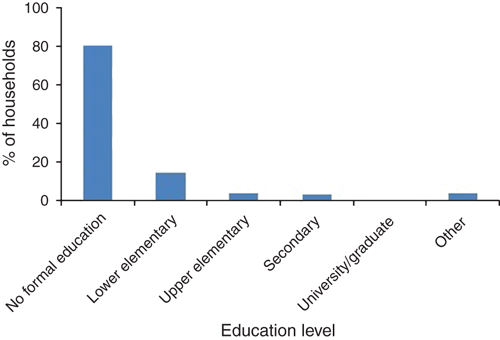
|
Household livelihood activities
The percentage of households surveyed (which was restricted to livestock-keeping households) engaged in different types of livelihood activities is shown in Fig. 3. Nearly all (97% and 96% of households in the West Golis and Tog-Dheer livelihood zones respectively) were involved in goat or sheep rearing, or both, and a significant share was involved in crop production (50% and 41%), camel rearing (38% and 36%) and cattle rearing (11% and 11%). Further, some households were engaged in additional activities including business, formal employment, food-aid and remittance (between 8% and 11%, depending on the activity and livelihood zone). When comparing the distributions of households engaging in the main activities (goat and sheep rearing, crop production, camel rearing and cattle rearing) between the livelihood zones, they were not statistically significantly (P = 0.890) different; however, when comparing the distributions for all livelihood activities between the livelihood zones, there was a significant (P = 0.009) statistical difference between the livelihood zones. For both livelihood zones, the most common number of livelihood activities a household engaged in was two, although it could range from one to five.
In addition to respondents indicating which livelihood activities the household is engaged in, they were also asked to rank the livelihood activities for importance. Of those household engaging in goat and sheep rearing, 80% indicated that it was their most important livelihood activity and 17% considered it to be the second-most important. Of those households engaged in camel rearing, all indicated that it was their most important livelihood activity, and of those engaged in cattle rearing, 6% indicated that it was their most important activity, with 47% considering it to be their second-most important activity. For households undertaking farming or crop production, 18% and 52% indicated that it was their most and second-most important activity respectively. The distributions of both first- and second-ranking livelihood activities were not significantly different for the two livelihood zones (P = 0.559 and 0.410 respectively). The household livelihood portfolio strongly reinforced the importance of livestock, in particular goat and sheep, to pastoral livelihoods. All of the female-headed households indicated that goat and sheep rearing was their most important livelihood activity.
Type of livestock production systems practiced
The main types of livestock production system practiced are given by species in Table 1. Across all species, the main types of production system practiced were fully nomadic, semi-nomadic and grazing in their own farm. There were also some households practicing mixed crop–livestock systems, and, to a lesser extent, the use of a zero-grazing or housed system. The distributions of livestock system practiced for each species was not significantly different between the two livelihood zones for goat, sheep and camel (P = 0.148, 0.238 and 0.289 respectively), but it was for cattle (P = 0.030). For cattle, the main difference was that keeping cattle in a mixed crop–livestock system was practiced in the Tog-Dheer livelihood zone (25%), but not the West Golis livelihood zone (0%).
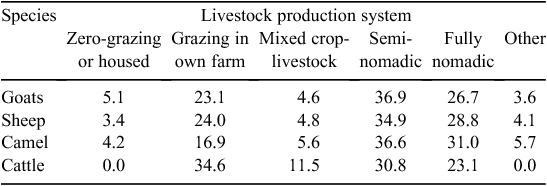
|
Household herd: species mix and herd size
Over all households surveyed, nearly all (98.5%) kept goat, the majority kept sheep (71.5%), some kept camel (37.0%) and a few kept cattle (11.5%). For the West Golis livelihood zone, the percentage of households keeping goat, sheep, camel and cattle was 99%, 79%, 38% and 12% respectively, whereas for the Tog-Dheer livelihood zone, it was 98%, 64%, 36% and 11% respectively (although these distributions were not significantly (P = 0.818) different between the two livelihood zones).
The main combinations of species kept by individual households are shown in Table 2. The most common combinations were goat and sheep (36% of all households), followed by camels, goats and sheep (24%) and goats only (23%) (these distributions were also not significantly (P = 0.150) different between the two livelihood zones).
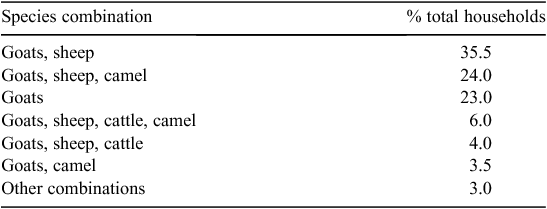
|
There was a large variation in the size of the household herds (animals owned by the household), as shown in Figs 4–7. Goat herd sizes ranged from 3 to 430, with a median of 48; sheep herd sizes ranged from 2 to 250, with a median of 24; camel herd sizes ranged from 1 to 52, with a median of 12; and cattle herd sizes ranged from 3 to 23, with a median of 12. Thus, the herd sizes for the small ruminants (sheep and goat) were larger than those for the large ruminants (camel and cattle). In comparing the two livelihood zones, most notably, West Golis had larger goat herds and Tog-Dheer larger camel herds. Specifically, for the West Golis livelihood zone, the median (and range of) herd sizes for goat, sheep, camel and cattle were 68 (13–430), 25 (4–187), 9 (1–22) and 12 (7–22) respectively, whereas for the Tog-Dheer livelihood these were 32 (3–246), 23 (2–250), 15 (1–52) and 9 (3–23) respectively.
In addition to the target species of the present paper, donkeys were kept by 20% of households, with an average herd size of 2.1 (and range of 1–4), and poultry were kept by 5.5% of households, with an average herd size of 6.5 (and range of 2–10). Further, one household kept six horses.
Previous reports on household species mix and herd size in the study sites were not available for comparisons to be made over time. Besides the present study, we could identify only one other report in Somalia giving similar information on species mix and herd size (from a survey undertaken in 1984 in southern Somalia: Al-Najim 1991). However, the fact that pastoralists often keep more than one species, so as to reduce risk to their livelihoods should one species be adversely affected (e.g. by disease), increase the utilisation of range vegetation (since sheep and cattle are primarily grazers, and goats and camels primarily browsers), increase the diversity of livestock products produced, and even out seasonal food resources (such as milk), is well documented (e.g. Dahl and Hjort 1976; Al-Najim 1991; McCabe 1990; Catley et al. 2013). Change in pastoral-species composition over time, in response to various factors including provision of new water supplies and export-market demand, has also been documented (e.g. Al-Najim 1991).
That households regaining stock (due to loss from disease, drought or other circumstances) typically invest in small stock, and particularly goat, before selling or trading the small stock to acquire larger stock, has also been documented (Dahl and Hjort 1976). This is because the small stock are the easiest to acquire (lowest cost), have a higher reproductive potential and, thus, faster herd growth rate, and are more easily disposed of than are larger stock. Here, 23% of households kept goats only, while the other households keeping only a single species were one household (0.5%) keeping sheep and two households (1%) keeping camel. For households keeping goats only, the median herd size was 20; for households keeping goat and sheep, the median herd sizes were 49 for goat and 18 for sheep; and for households keeping goats, sheep and camel, the median herd sizes were 59 for goat and 30 for sheep. This is in-line with initially investing in small stock (first goat and later sheep) and then, as herd size grows, investing in the larger stock.
Household herd composition
The composition of the household herds, in terms of the proportion of animals falling into different sex (male or female) and animal-type (adult, young, or unweaned) categories are given in Table 3. The most common sex by animal type combination across all species was adult female (45–51%, depending on the species), followed by adult males (15.5–19%). Of the adult males, the majority were intact (63–83%, depending on the species), while the remaining adult males were castrated. These distributions did not differ between the livelihood zones for goat and cattle (P = 0.600 and 0.083 respectively), although they did for sheep and camel (P < 0.001 and 0.001 respectively). For both sheep and camel, the main difference was a higher proportion of adult males in the West Golis livelihood zone than in the Tog-Dheer livelihood zone (16% versus 11% for sheep, and 22% versus 13% for camel respectively). For goats and sheep, almost all intact males were indicated as potential breeders, while for camel and cattle, the number of breeding males per household most commonly ranged between 1 and 3 (although for all species, many households applied various practices to limit breeding to specific animals, as described in further detail later in the paper). That adult female is the dominant animal-type present is both expected and consistent with previous reports (e.g. for camel in Somalia, Elmi 1989; Farah et al. 2004, 2007; Hussein 1987).

|
The percentage of adult females that were lactating (at the time of the survey, and on the basis of farmer responses rather than observed counts) was reported to be 50% for goat, 34% for sheep, 40% for camel and 37% for cattle (for West Golis, these figures were 53%, 31%. 34% and 35% respectively, whereas for Tog-Dheer they were 43%, 47%, 44%, 40% respectively). Previous reports on the percentage of adult camels lactating in Somalia have ranged from 31% to 74% (Hussein 1987; Elmi 1989; Farah et al. 2007), which is likely to be indicating strong year and seasonal differences. No previous reports on the percentage of adult females lactating for the other species could be found.
Perceived optimal herd size
Respondents were also asked to indicate the optimal number of adult females they would like to keep to maintain their livelihood. Responses varied, with median values (and ranges) being 100 (5–1000), 100 (4–500), 29 (0–50) and 11 (3–200) for goat, sheep, camel and cattle respectively. There were no noteworthy differences in responses between the livelihood zones, or between female and male respondents. The fact that pastoralists tend to favour large herds as a livelihood risk-reduction strategy is well documented (e.g. Dahl and Hjort 1976; McPeak and Barrett 2001), as are the varied environmental consequences of this (e.g. Gaani et al. 2002).
Animal ownership and entrustment to others
The majority of livestock (85–93%, depending on the species, for all respondents) were considered to be jointly owned by female and male members of the household. For each species, the pattern of ownership (as male, female or joint) was significantly different between female and male respondents (P = 0.001 for goat and sheep, P < 0.001 for camel, and P = 0.016 for cattle). For goats, sheep and camel (but most noticeably camel), the female respondents indicated more male ownership, and less joint or female ownership, than did the male respondents. For cattle, the female respondents indicated less female ownership and more joint ownership. The pattern of ownership within a species was also different when comparing the West Golis livelihood zone with the Tog-Dheer livelihood zone (P < 0.001 for sheep, goat and cattle, P = 0.020 for camel). Respondents in the West Golis livelihood zone indicated more male, and less joint and female ownership, than did those in the Tog-Dheer livelihood zone. These results indicated the subjectivity of interpreting the term ‘ownership’. Previous studies on camels in Somalia (Hussein 1987; Elmi 1989) have noted that livestock are often considered both individually or family, as well as communally, owned.
In total, 15% of households (19% and 10% in the West Golis and Tod-Dheer livelihood zones respectively) indicated that they currently entrusted one or more of their animals to the care of others. The most common species entrusted was goat (9.5% of households), followed by camel (5%) and sheep (4%), and rarely cattle (0.5%). Households often entrusted more than one species. The number of animals that were entrusted ranged from 1 to 20 per species, with the most common animal type entrusted being adult female. The animals were most commonly entrusted to relatives of the same clan (67% of households who entrusted), with the main reasons for entrustment including relocation to better pastures (named in 43% of the cases for entrusting a particular species), to allow a relative to have milk (23%), and to otherwise help a relative (16%). The keeping of livestock in different locations has been previously reported as a means of sharing risk (Little et al. 2001). The fact that Somali pastoralists’ loan livestock to relatives and friends in times of need has also been previously reported (Elmi 1989).
Herding arrangements
Households reported having between one and four livestock herds per household, where a herd (in this context) was defined as a group of animals managed as a unit, and including one or more than one livestock species. The total number of herds was 181 for study households from the West Golis livelihood zone and 136 for study households from the Tog-Dheer livelihood zone. The percentage of households keeping one, two, three and four herds was 59%, 30.0%, 8.0% and 3% respectively (these distributions were not significantly (P = 0.609) different between the two livelihood zones). The most common herd types were goats only (32% of all herds), mixed sheep and goats (22%), camels only (21%), sheep only (18.5%) and cattle only (5.5%; these distributions were also not significantly (P = 0.532) different between the two livelihood zones). Across all herd combinations, the majority had a single owner (91% in West Golis and 82% in Tog-Dheer), while the remainder had one or more owners (most commonly 2, but up to 3 in West Golis and 6 in Tog-Dheer). The reasons for households combining (or not-combining) different combinations of species into herds included their compatibility in relation to grazing or browsing habits, ability to travel and water requirements (Dahl and Hjort 1976). Household splitting of livestock into home-based and nomadic herds has been previously reported (Farah et al. 2004). For camel it has been noted that lactating, young and sick animals typically remain at the home-base, while breeding animals go with the nomadic herd, and that this herd splitting is a risk-spreading strategy (Farah et al. 2004).
Herding labour
Herding labour (Table 4) was primarily provided by household members, inclusive of both adults and children, where children were defined as being less than 15 years of age. For sheep and goat, the most common household members used in herding were adult females and children of either sex (for both livelihood zones), and, for the West Golis livelihood zone, adult males (the distributions of herding labour differed significantly by livelihood zone, with P = 0.002 and P = 0.018 for sheep and goat respectively). For camel, the most common household members used in herding were adult males, followed by male children, while for cattle the most common household members used in herding were male children, followed by adult males (these distributions did not significantly differ by livelihood zone, with P = 0.166 and P = 0.095 respectively). Some households (5–5.5%, depending on the species) did not use herders, while a few households (1–3%, depending on the species) used non-household labour. Overall, 54% of the households used children for herding labour (53% in the West Golis livelihood zone and 55% in the Tog-Dheer livelihood zone).
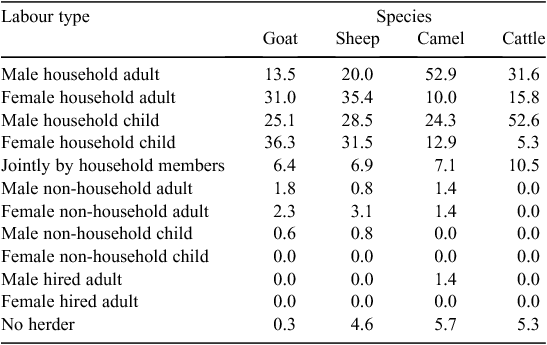
|
Livestock migration patterns and constraints to livestock migration
Livestock migration (i.e. where all or part of the household move with livestock in search of pasture and water for the animals) was practiced by 74% of households (80% in the West Golis livelihood zone and 67% in the Tog-Dheer livelihood zone), while the remaining households (26%) indicated that they were permanently settled with their livestock. Of the migrating households, 50% in the West Golis livelihood zone and 10% in the Tog-Dheer livelihood zone indicated permanent migration with their livestock over the past 12 months, while the remainder indicated that they had migrated with their livestock for part of the past 12 months (most commonly 1–2 months in the West Golis livelihood zone and 1 month in the Tog-Dheer livelihood zone, but up to 6 months in either livelihood zone). For about two-thirds of households that practiced migration (60% in West Golis and 71% in Tog-Dheer), the whole household migrated with their livestock; in other cases, only selected household members (most often adult males, or adult males and females) migrated with their livestock.
Of households that practiced livestock migration, close to half (41% in West Golis and 47% in Tog-Dheer) indicated that they could not follow their desired livestock migration pattern, with primary reasons stated for this being a lack of access to transportation (63% and 48% of those who could not follow their desired migration pattern in West Golis and Tog-Dheer respectively), no longer being able to access land due to fencing or enclosure (22% and 24%), and a lack of good pasture (7% and 21%). These constraints correspond to those previously reported (Gaani et al. 2002).
Households practicing livestock migration indicated the main source of information on pastures was by sending someone to investigate the availability of pasture and water (60% and 36% in West Golis and Tog-Dheer respectively), from other pastoralists (18% and 51%) and via traditional knowledge (16% and 29%). It is of note that no households indicated using media (such as radio) to obtain this information.
Breeding practices: breed-types kept
Respondents were asked to indicate the breed-type of livestock kept for each species. Named current breeds were short-ear Somali and long-ear Somali for goat (87% and 7% of goat-keeping households respectively), Black head Somali for sheep (99% of sheep-keeping households), ‘one-humped’ for camel (named by 96% of camel-keeping households; all camels in Somalia are dromedary (one-humped) and are most commonly referred as the Somali breed), and North Somali and Boran for cattle (68% and 14% of cattle-keeping household respectively, with the Boran being named by respondents only in the Tog-Dheer livelihood zone). Other respondents could not name a breed-type. The named breeds coincide with those reported in the companion study (Marshall et al. 2016). For more information on these breeds, see Muigai et al. (2016) and Wilson (2011).
Breeding practices: sources of breeding males
The main source of breeding males for all species was their being born into herd (reported by 96%, 92%, 71% and 58% of respondents answering this question for goat, sheep, camel and cattle respectively). Other main sources were a loan from a relative, friend or other pastoralist (8%, 6%, 14%, 42%), a gift from a relative, friend or other pastoralist (1%, 2%, 3%, 8%), and, for goat and camel, their being purchased from market (2% for goat, and 6% for camel). Between 77% and 85% of respondents (depending on the species) indicated that it would not be difficult to source a male breeding animal from outside their own herd should they desire to do so, suggesting that availability of breeding males is not a constraint to acquisition of new breeding males. When comparing the distributions of source of breeding male between the two livelihood zones, there was no significant difference for goat, sheep and cattle (P = 0.388, 0.597 and 0.707 respectively), whereas there was for camel (P = 0.006). The main difference between the livelihood zones for camel was that households in West Golis sourced mainly from being born into herd (44%) and loaned (28%), whereas households in Tog-Dheer sourced mainly from being born into herd (94%).
Pastoralists were also asked whether they had reservations about introducing a new male to the herd, and, if so, the reason(s) behind these reservations. For goat, sheep and cattle, 85% or more of respondents (depending on the species and livelihood-zone combination) indicated that they had no reservation about introducing a new male, while the remainder indicated that they would have reservations due to fighting, the female not accepting to mate with the new male, or because of the unknown performance of the new male. For camel, 77% of respondents (70% in West Golis and 84% in Tog-Dheer) indicated that they had no reservation, while the remaining 33% indicated that they would have reservations, citing the same reasons as for the other species.
Pastoralists were additionally asked to indicate what they were willing to pay for a male breeding animal. For goats and sheep, about one-fifth to one-quarter of respondents were not willing to pay (17% and 22% for goat in West Golis and Tog-Dheer respectively, and 23% and 28% for sheep in West Golis and Tog-Dheer respectively). Of those willing to pay, the most commonly indicated price was between US$51 and US$80 (for both livelihood zones). For camel and cattle, a higher percentage of respondents (30% and 32% for camel in West Golis and Tog-Dheer respectively, and 46% and 43% for cattle in West Golis and Tog-Dheer respectively) were not willing to pay. Of those willing to pay, the most commonly indicated price was between US$601 and US$900 for camel, and US$301 and US$600 for cattle (again for both livelihood zones). Note that these figures are indicative only, and need confirmation by a more robust willingness-to-pay study (such as using the double-bound approach described in Hanemann et al. 1991).
Breeding practices: sources of breeding females
Few households reported female animals entering their herd (other than by birth) during the 12-month period before the survey (7% for goat, 3% for sheep, 3% for camel, 14% for cattle; these distributions were not significantly different between the two livelihood zones, P = 1.0). The main sources of female animal acquisition were being purchased from market for goat and cattle, receiving as a gift for cattle, sheep and goat, receiving as bride-price for camel, and being on loan from a friend, relative or another pastoralist for all species.
Breeding practices: control and timing of mating
The use of various livestock mating practices is summarised in Table 5. Key practices employed included castration of non-breeding males (60% to 90% of households, depending on the species), culling of inferior males to prevent them from breeding (35–64%), purposely mating the best males to the best females (13–59%), allowing males to mate only a certain number of females (24–41%), separating male and female animals (39–76%) and, for sheep, use of an apron to prevent unwanted matings (63%). Presumably the higher use of aprons for sheep in comparison to other species is because it is most practical for this species. For goat, cattle and camel, the distributions of mating practices utilised was not different between the livelihood zones (P = 0.390, 0.308 and 0.886 respectively), whereas it was for sheep (P = 0.018). For sheep, this was mainly due to the practice of culling inferior males being more common in West Golis (79% of households keeping sheep) than in Tog-Dheer (47%).
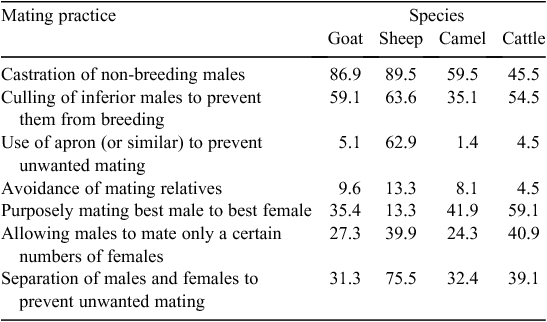
|
The use of year-round or seasonal mating is given in Table 6, with seasonal mating being employed by 53–70% of households (depending on the species) and year-round mating being employed by 30–47% of households (again depending on the species). For goat, sheep and cattle, these distributions were not significantly different across the livelihood zones (P = 0.093, 0.090 and 1.000 respectively), whereas it was for camel (P = 0.001). For camel, there was less seasonal and more year-round mating in West Golis than in Tog-Dheer (see Table 6 footnote for more details).

|
The main reason given for practicing seasonal mating was that animals are seasonal breeders (all species) and so progeny are born when the season is favourable (sheep and goat). The main reasons given for practicing year-round mating were breeding males and females together all year and being unable to control mating (all species but particularly goat), for year-round milk (camel and cattle), and being unable to manage animals if all were born within a short time period (sheep only). The fact pastoralists have a tendency to practice castration and seasonal breeding of camels is consistent with what has been previously reported (Elmi 1989; Farah et al. 2004; Hussein 1987); no references could be found in relation to these practices for the other species.
Breeding practices: detection of heat and pregnancy
The pastoralists reported using various methods to detect heat of female animals. For goat, sheep and cattle, the main reported indicators of heat were mounting (40–60% of pastoralists keeping the different species), proximity of females to males (35–57%), and restlessness (15–40%). Other heat signs reported were ceasing to graze for goats and sheep (12–15%), presence of discharge for cattle (11%), and lifting or moving of the tail for sheep (6%). For camels, the main reported indicators were proximity of female camels to male camels (74%) and restlessness of female camels (20%). The distributions of the approaches by which pastoralists detected heat did not differ by livelihood zone for goat, camel and cattle (P = 0.081, 0.283 and 0.882 respectively), although it did for sheep (P = 0.025). For sheep, the main difference was a higher use of the signs of mounting, animal ceasing to eat, and restlessness in the West Golis livelihood zone (46%, 22% and 27% respectively), compared with the Tog-Dheer livelihood zone (30%, 6%, and 12% respectively).
Pregnancy of animals was also detected by various methods. For goats, sheep and cattle, the main signs used to confirm pregnancy were named as males being prevented to mate (35–58% of pastoralists keeping the different species), reduction in milk production (22–51%), and growth in the size of the vulva (19–40%). Additional signs were male behaviour in goats and sheep (10–14%) and lifting and curving of tail in cattle (12%). For camels, the main indicators of pregnancy were named as lifting and curving of the tail (96%), followed by a reduction in milk production (18%). The distributions of the approaches by which pastoralists detected pregnancy did not differ by livelihood zone for any of the species (P = 0.634, 0.182, 0.260 and 0.601 for goat, sheep, camel and cattle respectively).
Previous literature on these issues relates to pregnancy signs in camel. These were lifting and curving of the tail (consistent with that reported here), curving of the neck when approached by a male camel, head lifted and ears pointed, nervousness and frequent urination (Elmi 1989; Farah et al. 2004).
Breeding practices: animal identification
The two main means of animal identification, across all species, were identification of the animal owner by branding (used by 75–98% of households, depending on the species) or ear-notching (21–48%). In some cases (15–25%), these two approaches were used in combination. In addition, a small number of households identified individual animals by ear-tagging or ear-tattooing (3–8%) or by the coat colour and other features of the animal (1–2%). No animal identification was used by 1–5% of households for goat, sheep and camel, and by 12% of households for cattle. The distributions of use of the main identification methods (tagging and ear-notching) did not differ by livelihood zone for any of the species (with P = 0.576, 0.545, 0.737 and 0.633 for goat, sheep, camel and cattle respectively).
Breeding practices: record keeping
In relation to livestock record keeping, the majority of households (65–82%, depending on the species) indicated that they kept mental records, while the remainder of households either kept no record (16–31%) or were unsure whether they kept records (2–3%). Only one household indicated that they kept written records (for goats). Mental record keeping was on issues such as animal parentage, births and deaths, animal performance, health care, and sales and purchases, among others. When comparing the distributions of record keeping (as mental versus none) across livelihood zones, there was no difference for camel and cattle (P = 0.190 and 0.686 respectively), whereas there was for goat and sheep (P = 0.001, in both cases). For goat and sheep, the level of mental record keeping was higher in the Tog-Dheer livelihood zone than in the West Golis livelihood zone (at 92% versus 73% for goat, and 95% versus 70% for sheep).
Breeding practices: information sources on breeding
Only 5.5% of the households (4% in West Golis and 7% in Tog-Dheer) indicated that they sought information on livestock breeding, or about livestock breeds, over the past 12 months. Information was sought on all species, but particularly sheep and goat, and the most common type of information sought was on ‘good breeding males’ (this was not specified in further detail). For the households that sought information on breeding, the information provider was always named as a friend, relative, or another pastoralist.
Beliefs on breeding issues: sex of progeny born
In relation to whether their livestock progeny were born in equal sex numbers, the majority of pastoralists were either unsure (38–41% of respondents, depending on the species) or felt this was true (27–36%). However, some pastoralists felt that more female progeny were born (18–23%) or that more male progeny were born (5–12%). For goat, sheep and cattle, there were no significant differences in this pattern between female and male respondents (P = 0.368, 0.730 and 0.587 respectively), whereas there was for camel (P = 0.039). For camel, the major difference was that 29% of male respondents, compared with 4% of female respondents, considered that more female progeny was born.
The percentage of pastoralists who actively tried to influence the sex of their livestock progeny was 14%, 11%, 17% and 23% for goats, sheep, camel and cattle respectively. The distributions of whether sex of livestock progeny could be influenced or not did not significantly differ by gender of the respondent for sheep, camel and cattle (with P = 0.143, 0.382 and 0.318 respectively), but it did for goat (P = 0.021). For goat, the main difference was that 15% of male respondents felt that they could influence the sex, in comparison to 6% of female respondents. The practices employed by these pastoralists to influence sex (which were similar across species) were mainly selecting male or female breeding animals that produced more of the desired sex (40–73% of those trying to influence sex, depending on the species), feeding animals well (55–80%), supplementing with minerals (55–80%), and feeding a special plant or plant extract (16–40%). The pastoralists employing these practices felt that they worked somewhat-well to very-well. All pastoralists who attempted to influence the sex of their progeny (with one exception) desired to increase the proportion of females, presumably to increase herd size. While there are some reports indicating that livestock sex ratio can be influenced by various factors (e.g. Rosenfeld and Roberts 2004), this influence was small.
Beliefs on breeding issues: transmission of livestock traits
Pastoral understanding on the transmission of livestock traits was assessed by asking the respondents whether eight traits were influenced by environment, inheritance, or a combination of both (Table 7). Taking growth rate as an example of a trait with moderate inheritance (i.e. influenced by both genetics and the environment, but more so the environment), 32% of respondents considered it being influenced by environment only, 27% by inheritance only, and 37% a combination of environment and inheritance (the remaining respondents were unsure). Taking coat colour as an example of a trait with a high inheritance (i.e. mainly influenced by genetics), 9% of respondents considered it being influenced by environment only, 19% by a combination of environment and inheritance, and 62% by inheritance only. Interestingly, for both milk production and reproductive ability, the most common answer (by ~50% of the respondents) was inheritance only; this is surprising, given these traits are strongly related to body condition and, thus, level of feed. Respondents indicating that traits had a heritable component were further asked whether both of the parents, or one parent in particular, influenced the trait. For all traits (except milk production), the most common answer given was equal influence by both parents. For milk production, the most common answers were equally both parents and female parent only. The distributions of these results between female and male respondents did not significantly differ for all traits (P = 0.056 to 0.588 depending on the trait), bar coat colour (where P = 0.001). For coat colour, the main difference was that 4% of female respondents indicated that it was controlled by ‘mainly environment, but with some influence of inheritance’ compared with 10% of male respondents.

|
When the respondents were asked ‘how do you consider traits that are inherited to be passed from one generation to the next’ the most common answer was ‘don’t know’ (83% and 62% of female and male respondents respectively), followed by ‘genetic material, genes or DNA’ (13% and 26%). The remaining respondents (4–12%) did not believe in the concept of trait inheritance. Here, the pattern of response between female and male respondents was significantly (P = 0.020) different.
Thus, although pastoralists select breeding animals in a sensible manner based on several relevant selection criteria (Marshall et al. 2016), few pastoralists appear to have, or be able to articulate, an understanding of inheritance from a biological sense.
Beliefs on breeding issues: inbreeding
So as to assess pastoral understanding of livestock inbreeding (which is caused by the mating of related livestock, and, if at significantly high levels, can result in reduced fitness and reproductive ability), pastorals were asked whether they considered the mating of related animals to be a problem. In total, 93% of respondents indicated they did not consider the mating of relatives to be a problem, and, further, indicated that they believed it to have no effect. In contrast, 7% indicated that they felt the mating of close relatives was a problem, with the most commonly named effects of this mating being ‘animals easily become sick’. This pattern of response was not significantly (P = 0.267) different between the female and male respondents.
Overall, the number of pastoralists demonstrating an understanding of the cause and effects of inbreeding was low. Concerns over potential high inbreeding levels in Somali camel herds have been previously raised (Farah et al. 2004). However, it is difficult to comment on the likely levels of inbreeding in the absence of genetic testing, due to the multiple contributing factors (such as, for example, that most breeding animals are born into the herd, but there is not uncommon loan of animals or introduction of replacements following drought).
Constraints to livestock production in general and improvement of animals through breeding
Constraints to livestock production in general, and specifically to the improvement of animals through breeding, were assessed by asking each respondent to name the two main constraints for each of these, by species.
Almost all households (93–100%, depending on the species) indicated that there was one or more constraints to livestock production in general. The main constraints named were ‘recurrent drought resulting in limited feed and water’ (63–77% of households, depending on the species), ‘animal disease’ (32–50%), ‘being unable to access grazing land that could be accessed in the past’ (15–25%), predators (5–16%, and, at the higher end of this range, for sheep and goat), and lack of or poor veterinary care (5–12%). These correspond to the results of previous studies (Gaani et al. 2002; National Livestock Policy Republic of Somaliland 2006). These distributions (of the main constraints and including that of no constraint, for each species) did not differ by livelihood zone for sheep, camel and cattle (with P-values of 0.183, 0.055 and 0.541 respectively), but they did for goat (P = 0.036). For goat, the main difference was that lack of access to land was more commonly cited for Tog-Dheer (25%) than for West Golis (8%). These distributions did not differ by gender of the respondent (with P-values for goat, sheep, camel and cattle of 0.060, 0.277, 0.360 and 0.721 respectively).
Between 49% and 57% of households (depending on the species) indicated that there was one of more constraints in relation to improvement of their livestock through breeding. The main constraints named were lack of knowledge to identify good breeding animals from their own herd or flock (43–58% of households naming a constraint, depending on the species), and lack of knowledge of breeding practices in general (30–42%), indicating that some pastoralists may require capacity building in these areas and/or reassurance that their current breeding practices are sound. Another main named constraint was poor reproductive performance of animals (6–11%), which may reflect animals being in too poor body condition (due to lack of feed) to reproduce. These distributions (of the main constraints and including that of no constraint, for each species) did not differ by livelihood zone (with P-values for goat, sheep, camel and cattle of 0.863, 0.389, 0.133 and 0.636 respectively) nor gender of the respondent (P = 0.942, 0.866, 0.547 and 1.0 respectively).
Livestock risk management
Respondents were asked to indicate the importance of various strategies to reduce risks to their livelihood from livestock losses during bad years, such as drought years. The three most important strategies (Table 8) were production of livestock feed to store for bad years, purchase of livestock feed to store for bad years, and saving money (cash) so that livestock inputs can be purchased, which had been practiced by 53%, 51% and 33% of households over previous years respectively. This aligns well with the key constraint to livestock production being named as recurrent drought, resulting in limited feed. There was no significant difference in the mean important scores (given in Table 8) between female and male respondents for the various risk management strategies (with P-values ranging from 0.166 to 0.958, depending on the strategy). Further, there was no significant difference in the distributions of strategies used over the past year between the two livelihood zones (P = 0.175).
Discussion
Limited studies on livestock management practices of pastoralists within Somalia have been reported. Besides the present study and its companion papers (Marshall et al. 2014, 2016), we are aware of several studies in camel (including Watson 1986; Hussein 1987; Elmi 1989, 1991; Herren 1990; Baumann and Zessin 1992; Hjort af Ornäs 1993; Hjort af Ornäs and Hussein 1993; Farah et al. 2007), one for sheep and goats (Bourzat et al. 1992), and none for cattle. In particular, the limited information on sheep and goats is surprising, given the high importance of these species to the livelihoods of Somalis as well as the national economy.
One conclusion provided in the companion paper to the present study (Marshall et al. 2016) was that there was a strong alignment among the livestock selection criteria used by the Somali pastoralists, their reasons for keeping livestock, and the market requirements. It was further suggested that this is not surprising, given the intimate and long-standing relationship between Somali pastoralists and their livestock. Results presented here also suggest that pastoralists employ sound breeding practices, although some areas for capacity building, such as on inbreeding, were highlighted.
The present study incorporated a component on beliefs on breeding issues, in relation to sex of progeny born, trait inheritance, and inbreeding, being something that is rarely documented. It is notable that few pastoralists appear to understand inheritance from a biological viewpoint, despite the overall sound breeding practices and purposeful selection of breeding animals using sensible selection criteria (see Marshall et al. 2016). A limitation of the present study was that this was not explored in more detail. A deeper understanding on pastoral beliefs on inheritance, from, for example, an anthropological study, may be useful, particularly if this understanding were used to shape how capacity building on breeding is addressed.
In comparing responses from female and male respondents (which was reported for animal ownership, beliefs on breeding issues, constraints to livestock production, and livestock risk management, among others), there were little differences baring the more notable exceptions of livestock ownership and understanding of inheritance mechanisms. As suggested earlier, the gendered differences observed on animal ownership may reflect perception differences in the meaning of ownership between women and men which, while not explicitly explored in the present study, has been reported to differ (Galiè et al. 2015). The gendered difference on the understanding of inheritance mechanisms, which was known by a higher proportion of men than women, is interesting and requires further investigation to understand why. The fact that there was only minor gender difference on other perception issues, despite intra-household division of labour and decision making on livestock in the majority of households (the present paper; Marshall et al. 2016), may suggest that these are discussed between male and female members within a household.
Livestock recording in written format was not practiced by any of the pastoralists (bar one case), although the majority of pastoralists indicated that they kept mental records. The lack of written records may be related to low levels of formal education and, thus, low literacy. Sustainable and permanent (e.g. written or electronic) record keeping has, on the whole, been difficult to achieve in developing-country livestock productions systems. This is largely attributable to the lack of incentives to this end, such as the provision of timely feedback that is used to inform herd management decisions (for example, when to vaccinate). However, recent technologies, such as data collection via mobile phones with customised software, linked to platforms that add value to the data and return feedback, provide new opportunities and are being trialled in some East African countries. As Somaliland develops, further consultation with the livestock keepers should be undertaken to determine whether such a system would be of value to them, and where and when it would be feasible (considering issues such as priority of the intervention, given other constraints, and resource requirements including on human capacity), towards a potential trial.
Productivity data on livestock in Somalia is sparse. Table 9 summarises key trait data for the Somali camel, Black head Somali sheep, and Somali short-ear goat (the most common breeds within the study sites) from studies undertaken either in Somalia or the neighbouring countries of Ethiopia and Kenya. No studies specifically on the productivity of northern Somali cattle were identified. The available studies on camel, sheep and goat, while limited, are indicative of low overall productivity (due to the high mortality rates and low reproductivity) typical of livestock in many developing country livestock production systems constrained by feed and animal disease. While there is insufficient data to comment on variation in productivity across years/seasons, this is also expected to be high, given the varied climatic conditions. Given the importance of livestock to Somalia’s economy, additional livestock productivity data, as well as livestock census data, are warranted.
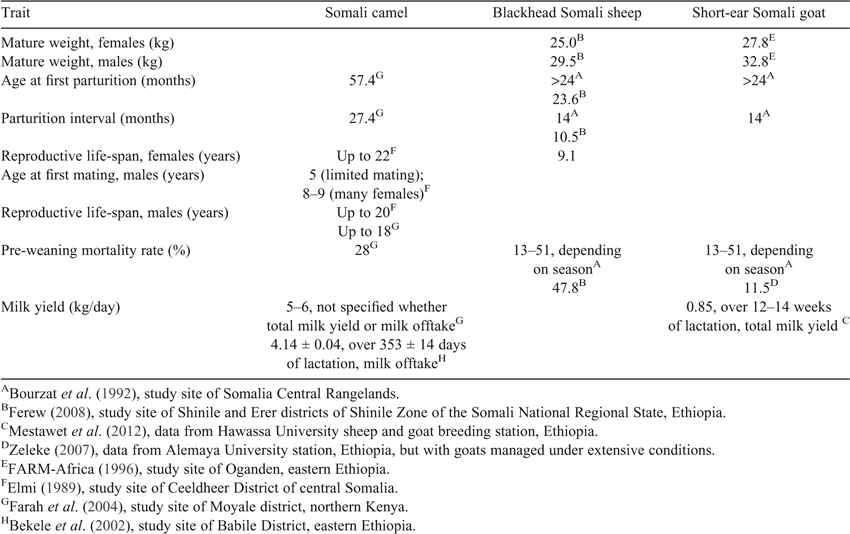
|
It is well recognised that droughts are a main constraint to livestock keeping in Somalia. While the pastoralists indicated several practices to reduce livestock losses in times of drought, including availing livestock feed either by production and storage or purchase, these were practiced only by a subset of the pastoralists. Additionally, many pastoralists could not access their preferred migration routes. The consequences of drought on Somalia livestock have been reported to include rapid deterioration in body condition, high occurrence of abortions, and high frequency of disease (FAO 2014). The issue of sustainable livestock feed and water supply needs urgent addressing and is currently the focus of several development projects in certain regions. However, more needs to be done in this area, particularly via implementing appropriate rangeland management practices, fodder production and preservation techniques, and land- and water-use and access policies. The continued use of breeds well adapted to the local environmental conditions will remain critical.
Limitations of the present study included the relatively modest sample size (200 households; 100 from each of the two study sites), the use of a household questionnaire alone rather than coupling this with a more qualitative survey (which would add value to particular survey components, such as beliefs on breeding issues), and the reliance on farmer recall for some data (such as herd size), which may not be accurate. This said, these are not uncommon limitations for surveys of this nature. A major advantage of the present study was the inclusion of both female and male respondents (rather than the main respondents being male household heads, as in many previous studies), which gives visibility to pastoralists of both genders and also allows for gendered comparisons to be made.
Overall, the present study, coupled with those of Marshall et al. (2014, 2016), has provided a rounded documentation of breeding practices of pastoralists and agro-pastoralists located in the Tog-Dheer region of Somaliland. Similar studies on other livestock management practices, including livestock feeding and health care, as well as pastoral adaptation practices to climate change, are also recommended. Together, these would contribute to selection of best-bet intervention packages for increased livestock productivity, an intervention area that seems critical, along with others such as maintaining or strengthening market access, for sustainable growth of the Somali livestock sector.
Conflicts of interest
The authors declare no conflicts of interest.
Acknowledgements
This paper is one of a series of outputs of a capacity-building program for the Intergovernmental Authority on Development (IGAD) Sheikh Technical Veterinary School and Reference Centre (ISTVS) staff that was implemented by the International Livestock Research Institute (ILRI) in partnership with Terra Nuova and funding from Danida. We are grateful to the ISTVS junior research assistants who implemented the household surveys, namely Mohamed Nur Jama, Omar Mohamud Salah, Asma Bile Hersi, Mohamed Said Abdulla, Ali Mohamed Ali, Mohamed Sheikh Elmi Fahiye (Awliyo), Nashad Farah Awale, Musse Mohamed Awale, Amina Hussein Mohamud, Abdinasir Ali Mohamed, Mustafe Mohamed Suleiman, and Hibo Hassan Elmi. We are also grateful to IGAD for allowing the ISTVS staff to participate in this capacity-building activity, and ISTVS management for logistical support. We very sincerely thank the female and male Somali pastoralists who participated in this study, for their time and input.
References
Al-Najim MN (1991) ‘Changes in the species composition of pastoral herds in Bay Region, Somalia.’ (Overseas Development Institute: Mogadishu, Somalia)Baumann MPO, Zessin KH (1992) Productivity and health of camels (Camelus dromedarius) in Somalia: associations with trypanosomosis and brucellosis. Tropical Animal Health and Production 24, 145–156.
| Productivity and health of camels (Camelus dromedarius) in Somalia: associations with trypanosomosis and brucellosis.Crossref | GoogleScholarGoogle Scholar |
Bekele T, Zeleke M, Baars RMT (2002) Milk production performance of the one humped camel (Camelus dromedarius) under pastoral management in semi-arid eastern Ethiopia. Livestock Production Science 76, 37–44.
| Milk production performance of the one humped camel (Camelus dromedarius) under pastoral management in semi-arid eastern Ethiopia.Crossref | GoogleScholarGoogle Scholar |
Bourzat D, Gautsch KD, Baumann MPO, Zessin KH (1992) Major demographic parameters for white somali goat and black-headed somali sheep in the Somalia central rangeland. In ‘Small ruminant research and development in Africa. Proceedings of the first biennial conference of the African small ruminant research network’. (Eds B Rey, SHB Lebbie, L Reynolds) pp. 159–175. (ILRAD: Nairobi, Kenya)
Catley A, Lind J, Scoones I (2013) ‘Pastoralism and development in Africa: dynamic change at the margins.’ (Routledge: Abingdon, UK)
Dahl G, Hjort A (1976) ‘Having herds: pastoral herd growth and household economy.’ (Department of Social Anthropology, University of Stockholm)
Elmi AA (1989) ‘Camel husbandry and management by Ceeldheer pastoralists in central Somalia.’ (Overseas Development Institute: Mogadishu, Somalia)
Elmi AA (1991) Livestock production in Somalia with special emphasis on camels. Nomadic Peoples 1, 87–103.
FAO (2010) ‘5-year strategy and plan of action in Somalia, 2011–2015.’ (Food and Agriculture Organization of the United Nations: Rome)
FAO (2014) ‘Impact of drought on livestock production and productivity in Somaliland.’ Available at http://www.somalilandsun.com/images/PDF/Impact_of_Drought_prepared_FAO._1.pdf [Verified 15 June 2017]
Farah KO, Nyariki DM, Ngugi RK, Noor IM, Guliye AY (2004) The Somali and the camel: ecology, management and economics. Anthropology 6, 45–55.
Farah Z, Mollet M, Younan M, Dahir R (2007) Camel dairy in Somalia: limiting factors and development potential. Livestock Science 110, 187–191.
| Camel dairy in Somalia: limiting factors and development potential.Crossref | GoogleScholarGoogle Scholar |
FARM-Africa (1996) ‘Goats types of Ethiopia and Eritrea. Physical descriptions and management systems.’ (The International Livestock Research Institute: Kenya)
Ferew F (2008) On-farm characterization of Blackhead Somali sheep breed and its production system in Shinile and Erer districts of Shinile zone. PhD Thesis, Haramaya University, Haramaya. Ethiopia.
FSNAU-Somalia (2005) ‘Livelihood baseline profiles: Golis-Guban pastoral.’ (Food Security and Nutrition Analysis Unit – Somalia, Food and Agricultural Organisation of the United Nations: Rome)
FSNAU-Somalia (2011) ‘Livelihood baseline profiles: Toghdeer.’ (Food Security and Nutrition Analysis Unit – Somalia, Food and Agricultural Organisation of the United Nations: Rome)
FSNAU-Somalia (2012) ‘Gender in emergency food security, livelihoods and nutrition in Somalia.’ (Food Security and Nutrition Analysis Unit – Somalia, Food and Agricultural Organisation of the United Nations: Rome)
FSNAU-Somalia (2014a) ‘Somalia livelihood zones.’ (Food Security and Nutrition Analysis Unit – Somalia, Food and Agricultural Organisation of the United Nations: Rome)
FSNAU-Somalia (2014b) ‘Food security and nutritional analysis post-deyr 2013/14.’ Technical series report no. VII 54. (Food Security and Nutrition Analysis Unit – Somalia, Food and Agricultural Organisation of the United Nations: Rome)
Gaani MX, Axmed CY, Kille MC, Xasan JN, Xasan CM, Ibrahim MJ, Axmed CM, Ibrahim X (2002) ‘Regulating the livestock economy of Somaliland.’ (Academy for Peace and Development: Hargeisa, Somaliland, Somalia)
Galiè A, Mulema A, Benard MAM, Onzere SN, Colverson KE (2015) Exploring gender perceptions of resource ownership and their implications for food security among rural livestock owners in Tanzania, Ethiopia, and Nicaragua. Agriculture & Food Security 4, 2
| Exploring gender perceptions of resource ownership and their implications for food security among rural livestock owners in Tanzania, Ethiopia, and Nicaragua.Crossref | GoogleScholarGoogle Scholar |
Hanemann M, Loomis J, Kanninen B (1991) Statistical efficiency of double-bounded dichotomous choice contingent valuation. American Journal of Agricultural Economics 73, 1255–1263.
| Statistical efficiency of double-bounded dichotomous choice contingent valuation.Crossref | GoogleScholarGoogle Scholar |
Herren V (1990) ‘Camel milk production and marketing in Yaq Bariweyne area, southern Somalia (Camel Forum 32).’ (Somali Academy of Sciences and Arts: Mogadishu, Somalia)
Hjort af Ornäs A (1993) ‘The multi-purpose camel: interdisciplinary studies on pastoral production in Somalia.’ (Uppsala University: Uppsala, Sweden)
Hjort af Ornäs A, Hussein MA (1993) ‘Camel herd dynamics in southern Somalia: long-term development and milk production implications.’ (EPOS, Program on Environmental Policy and Society, Uppsala University: Uppsala, Sweden)
Hope ACA (1968) A simplified Monte Carlo significance test procedure. Journal of the Royal Statistical Society. Series B. Methodological 30, 582–598.
Hussein MA (1987) ‘Traditional practices of camel husbandry and management in Somalia.’ (Somali Academy of Sciences and Arts: Mogadishu, Somalia)
Little PD, Mahmoud H, Coppock DL (2001) When deserts flood: risk management and climatic processes among East African pastoralists. Climate Research 19, 149–159.
| When deserts flood: risk management and climatic processes among East African pastoralists.Crossref | GoogleScholarGoogle Scholar |
Marshall K, Mtimet N, Wanyoike F, Ndiwa N (2014) The complex and gender differentiated objectives of livestock keeping for Somali pastoralists. In ‘Proceedings of the 10th world congress of genetics applied to livestock production’, 17–24 August 2014, Vancouver, Canada. Paper 419.
Marshall K, Mtimet N, Wanyoike F, Ndiwa N, Ghebremariam H, Mugunieri L, Costagli R (2016) Traditional livestock breeding practices of men and women Somali pastoralists: trait preferences and selection of breeding animals. Journal of Animal Breeding and Genetics 133, 534–547.
| Traditional livestock breeding practices of men and women Somali pastoralists: trait preferences and selection of breeding animals.Crossref | GoogleScholarGoogle Scholar |
McCabe JT (1990) Turkana pastoralism: a case against the tragedy of the commons. Human Ecology 18, 81–103.
| Turkana pastoralism: a case against the tragedy of the commons.Crossref | GoogleScholarGoogle Scholar |
McPeak JG, Barrett CB (2001) Differential risk exposure and stochastic poverty traps among East African pastoralists. American Journal of Agricultural Economics 83, 674–679.
| Differential risk exposure and stochastic poverty traps among East African pastoralists.Crossref | GoogleScholarGoogle Scholar |
Mestawet TA, Girma A, Ådnøy T, Devold TG, Narvhus JA, Vegarud GE (2012) Milk production, composition and variation at different lactation stages of four goat breeds in Ethiopia. Small Ruminant Research 105, 176–181.
| Milk production, composition and variation at different lactation stages of four goat breeds in Ethiopia.Crossref | GoogleScholarGoogle Scholar |
Muigai A, Matete G, Aden HH, Tapio M, Okeyo AM, Marshall K (2016) ‘The indigenous farm genetic resources of Somalia: preliminary phenotypic and genotypic characterization of cattle, sheep and goats.’ (International Livestock Research Institute: Nairobi, Kenya)
National Livestock Policy, Republic of Somaliland (2006) National Livestock Policy, 2006 to 2016. Available at http://www.somalilandlaw.com/Somaliland_Livestock_Policy_2006-1.pdf [Verified 15 June 2017]
OCHA (2016) ‘Consequences of drought in Somalia, November 2016.’ (United Nations Office for the Coordination of Humanitarian Affairs) Available at http://reliefweb.int/report/somalia/consequences-drought-somalia-november-2016 [Verified 15 June 2017]
Rosenfeld CS, Roberts R (2004) Maternal diet and other factors affecting offspring sex ratio: a review. Biology of Reproduction 71, 1063–1070.
| Maternal diet and other factors affecting offspring sex ratio: a review.Crossref | GoogleScholarGoogle Scholar |
SCCIA (2014) Somaliland Chamber of Commerce, Industry and Agriculture yearly report for the period 01–01–14 – 31–12–14. Somaliland Chamber of Commerce, Hargeisa, Somaliland, Somalia.
Somalia NAPA (2013) ‘Somalia national adaptation programme of action on climate change.’ Available at http://unfccc.int/resource/docs/napa/som01.pdf [Verified 15 June 2017]
Wanyoike F, Mtimet N, Ndiwa N, Marshall K, Godiah L, Warsame A (2015) Knowledge of livestock grading and market participation among small ruminant producers in northern Somalia. East African Agricultural and Forestry Journal 81, 64–70.
| Knowledge of livestock grading and market participation among small ruminant producers in northern Somalia.Crossref | GoogleScholarGoogle Scholar |
Watson RM (1986) ‘A photogrammetric sampling of camels to deduce the age structure of their populations in southern Somalia (in Camel Forum).’ (Somali Academy of Sciences and Arts: Mogadishu, Somalia)
Wilson RT (2011) Populations and production of fat-tailed and fat-rumped sheep in the Horn of Africa. Tropical Animal Health and Production 43, 1419–1425.
| Populations and production of fat-tailed and fat-rumped sheep in the Horn of Africa.Crossref | GoogleScholarGoogle Scholar |
Zeleke ZM (2007) Environmental influences on pre-weaning growth performances and mortality rates of extensively managed Somali goats in eastern Ethiopia. Livestock Research for Rural Development 19, 186


